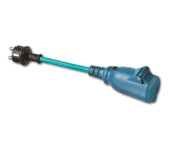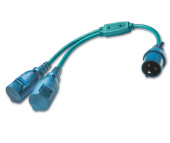Boat shore power systems are essential for providing electrical power to a boat while it is docked. These systems include boat shore power cords and plugs, which connect the vessel to shore-based power sources. This allows boaters to use onboard electrical systems and appliances without relying on the boat’s batteries, ensuring a continuous and reliable power supply.
|
1-2 weeks delivery time The ABL Shore Power Socket is designed for easy and reliable shore power connection, ensuring a secure and waterproof link for your boat. Available in both deck mounting and built-in types, this high-quality socket is perfect for marine applications, providing the best European craftsmanship for your vessel's electrical needs.
|
$ 10,59
Type:
| |||
|
1-2 weeks delivery time The ABL EE Shore Power Cable Plug is a high-quality plug and socket system designed for marine applications. Crafted with precision, it ensures complete waterproof protection, offering long-lasting reliability for your boat's electrical system. Trust in these top-quality components for uninterrupted power connections.
|
$ 8,89
Type:
| |||
|
1-2 weeks delivery time The Mastervolt Shore Power Adapters are designed to prevent damage to your main onshore power cable while ensuring a reliable power connection. These adapters feature a durable, waterproof, and UV-resistant design, making them the ideal choice for marine applications. Trust in these high-quality European products for your boat’s power system.
|
$ 46,72
Type:
| |||
|
1-2 weeks delivery time The Mastervolt Shore Cable Splitter Tee is a Y-splitter designed for CE plugs, featuring a built-in voltage indicator for added convenience and safety. Its corrosion-resistant joints and bayonet locks ensure a reliable, secure, and waterproof connection, making it ideal for demanding marine environments.
|
$ 155,88
-
+
| |||
What are the key differences between a 30 amp and 50 amp shore power cord, and when should each be used for a marine boat?
The key difference between a 30 amp and 50 amp shore power cord lies in their capacity to handle electrical loads. A 30 amp cord typically supports up to 125 volts and is suitable for smaller boats or RVs with less demanding power needs, connecting through a 30a inlet and female connector. In contrast, a 50 amp cord can handle more significant power requirements, often 125/250 volts, making it ideal for larger boats with multiple systems running simultaneously. It connects to a 50a male plug and marine shore power inlet, ensuring safe and reliable power distribution through the marine shore power system.
In addition to selecting the appropriate shore power cord, it’s important to consider the overall setup of your marine electrical system, including circuit breakers, bilge pumps, and converters. For example, when using a 30 amp shore power cord, you may need a pigtail boat adapter to connect to different power sources, such as an adapter ss2-50p male 50a plug for higher capacity needs. Additionally, RV cords and extension cords designed for marine use, like a 3ft RV marine boat shore power adapter, can extend the reach of your power connection while ensuring compatibility with various cordsets and cord connectors. Utilizing pigtail adapters and splitter with locking ring** options can help manage multiple AC power inputs safely, maintaining compliance with ABYC standards and preventing issues like stray currents or electrocution at the dock pedestal.
How does a marine boat shore power adapter facilitate the connection between different shore power systems on a boat?
A marine boat shore power adapter allows different shore power systems to connect seamlessly by matching the plug types and voltage requirements. For example, a Marinco shore power adapter can connect a 30 amp 125V shore power cord to a 50 amp receptacle, ensuring safe and reliable power transfer. These adapters are essential for converting power between various setups, whether you're at a marina or connecting to an RV power source, helping to maintain the integrity of your marine boat shore power system.
What is the function of a smartplug in a marine shore power setup, and how does it improve safety?
The function of a smartplug in a marine shore power setup is to provide a safer and more secure connection between the boat and the shore power source. Unlike traditional plugs, a smartplug minimizes the risk of overheating by ensuring a tight, secure connection that prevents arcing between conductors. Additionally, its design often includes features like a locking ring and collar to maintain a watertight seal, further reducing the risk of hot spots and potential fire hazards, which enhances overall safety in the marine environment.
What types of Marine Electrical items do you have in your catalog?
Marine Generator, Boat Generator, Marine Battery Charger, Boat Battery Charger, Marine Battery, Lithium Marine Batteries, AGM Marine Battery, Marine Gel Batteries, Boat Battery, Lithium Boat Batteries, AGM Boat Battery, Gel Batteries for Boats, Marine Battery Box, Boat Battery Box, Boat Battery Switch, Marine Battery Cable, Boat Battery Cable, Marine Battery Monitor, Boat Battery Monitor, Boat Inverter, , Marine Inverter, Boat Inverter Charger, Marine Inverter Charger, Marine Shore Power Cord Boat Shore Power, Shore Power




